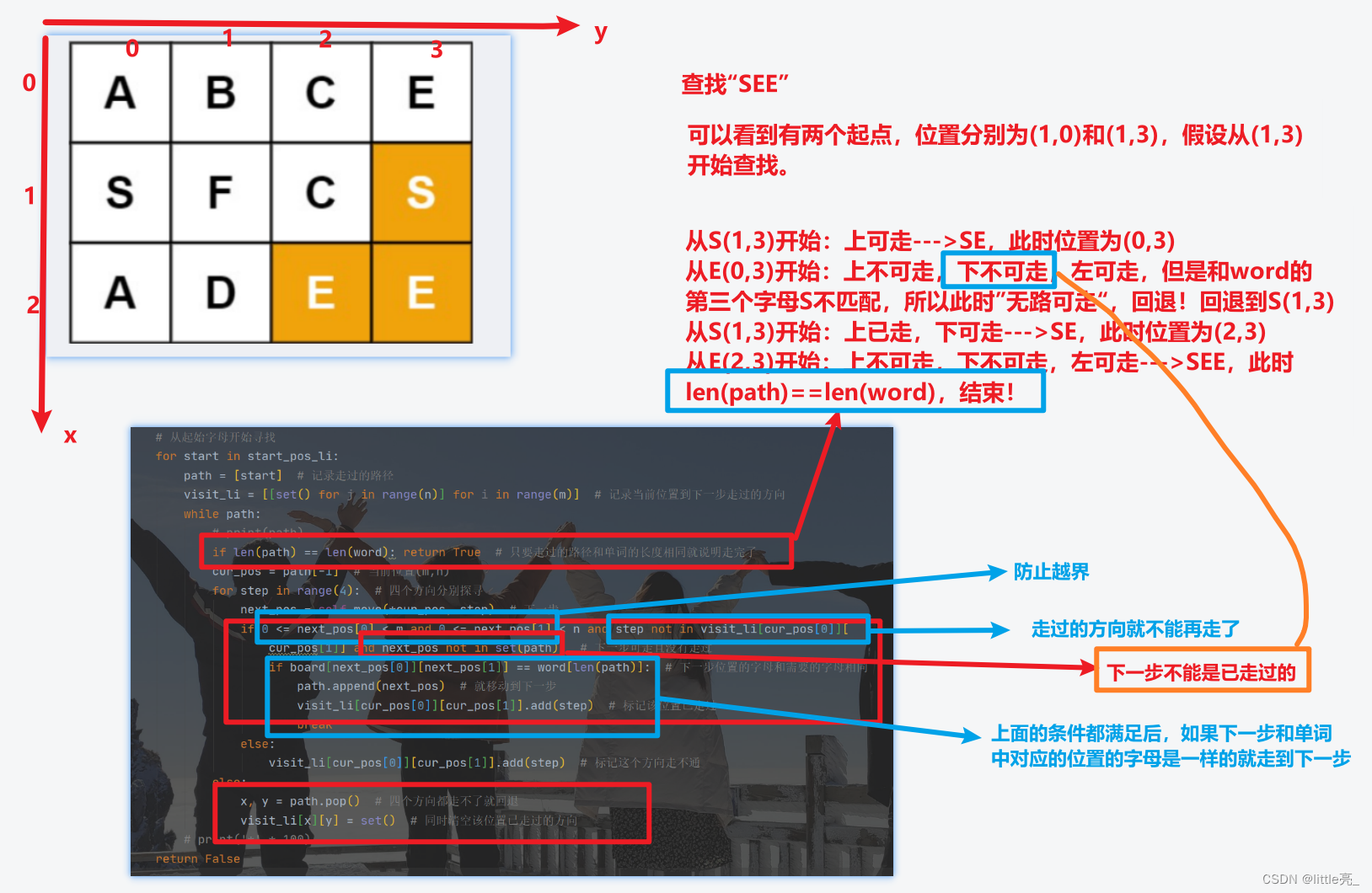当前位置:网站首页>Leetcode word search (backtracking method)
Leetcode word search (backtracking method)
2022-07-05 04:54:00 【Little light_】
subject
Given a m x n Two dimensional character grid board And a string word word . If word Exists in the grid , return true ; otherwise , return false .
The words must be in alphabetical order , It's made up of letters in adjacent cells , among “ adjacent ” Cells are those adjacent horizontally or vertically . Letters in the same cell are not allowed to be reused .
Example 1:
Input :board = [["A","B","C","E"],["S","F","C","S"],["A","D","E","E"]], word = "ABCCED"
Output :true
Example 2:
Input :board = [["A","B","C","E"],["S","F","C","S"],["A","D","E","E"]], word = "SEE"
Output :true
Example 3:
Input :board = [["A","B","C","E"],["S","F","C","S"],["A","D","E","E"]], word = "ABCB"
Output :false
Tips :
m == board.length
n = board[i].length
1 <= m, n <= 6
1 <= word.length <= 15
board and word It consists of upper and lower case English letters onlysource : Power button (LeetCode)
link :https://leetcode.cn/problems/word-search
Copyright belongs to the network . For commercial reprint, please contact the official authority , Non-commercial reprint please indicate the source .
Ideas
Because I just did a maze problem not long ago , So after reading this question , I found it amazingly similar to walking through a maze , It's just that the conditions change when we take the next step . however , It still cost me 2 How close are you to 3 It took hours to write !
, alas , Don't say the , It's still too much for me .
Get down to business ( Food can't be a reason for my laziness )
First , Whether it's maze walking or this problem , There must be a starting point , For this question , If you try one by one , That would be too time-consuming , So I first traverse the whole grid , Find the position of the letter that is the same as the first letter of the word you want to find :
start_pos_li = [] # Record the position of the first letter of the word word_set = set() # All letters in the table m, n = len(board), len(board[0]) for i in range(m): for j in range(n): word_set.add(board[i][j]) if board[i][j] == word[0]: start_pos_li.append((i, j))The found letters are added to start_pos_li In this list , Easy to find in the future, directly start from these locations .
At the same time, I also set up a set word_set, Save all the letters appearing in the grid , Before the official search , You can make a simple judgment to quickly get the answer of some chestnuts :
for s in word: if s not in word_set: return False # As long as there is a letter not in the table, it returns FalseAs the code shows , Traverse the words you need to find , As long as there is a letter not in the set, it will be returned directly False.
Now let's start the formal search
1. First define a move rule :
# Move ( Four directions ) def move(self, x, y, direction): if direction == 1: return (x - 1, y) elif direction == 2: return (x + 1, y) elif direction == 3: return (x, y - 1) else: return (x, y + 1)1 Represents moving up ,2 Represents moving down ,3 Represents shift left ,4 For shift right ; Here I take the horizontal axis as y Axis , Vertical axis as x Axis , therefore When moving up and down x Axis found changes , When moving left and right y The axis changes .
2. Begin to walk tentatively
a. Define a “ Stack ” To save the path
path = [start] # Record the pathIn fact, here is a list , But only using append() and pop() Method , Then it behaves like a stack .
b. Define a list to save the direction of each grid
visit_li = [[set() for j in range(n)] for i in range(m)] # Record the direction from the current position to the next stepHere I use a set to store the direction of each grid , A grid can store up to four directions , That is, up and down, around ; Unlike going through a maze , In maze walking, it is represented by two values :0 Represents that the current grid has not passed ,1 Represents that the current grid has left ; Because here is a word , It requires a continuous sequence , The current grid may not come from this direction , But you can come from the other direction .( That is, take the grid from different directions , The sequences obtained are all different )
c. Probe + to flash back
# Start with the initial letter for start in start_pos_li: path = [start] # Record the path visit_li = [[set() for j in range(n)] for i in range(m)] # Record the direction from the current position to the next step while path: # print(path) if len(path) == len(word): return True # As long as the path is the same as the length of the word, it means that you are finished cur_pos = path[-1] # The current position (m,n) for step in range(4): # Explore in four directions next_pos = self.move(*cur_pos, step) # next step if 0 <= next_pos[0] < m and 0 <= next_pos[1] < n and step not in visit_li[cur_pos[0]][ cur_pos[1]] and next_pos not in set(path): # The next step can be taken without going through if board[next_pos[0]][next_pos[1]] == word[len(path)]: # The letters in the next position are the same as those required path.append(next_pos) # Just move to the next step visit_li[cur_pos[0]][cur_pos[1]].add(step) # Mark that the position has passed break else: visit_li[cur_pos[0]][cur_pos[1]].add(step) # Mark that this direction won't work else: x, y = path.pop() # If you can't walk in four directions, go back visit_li[x][y] = set() # At the same time, clear the direction that the position has passedFrom the beginning , Test whether the four directions can go in turn , If the walkable point is updated to the current position , And then continue to test , If to a certain point , None of the four directions will work , Then go back , Go back to the previous step ; Continue the direction you didn't finish last time , Take the following chestnut as an example :
Source code
class Solution:
def exist(self, board: List[List[str]], word: str) -> bool:
'''
It's like going through a maze , Set up 4 Two directions of movement , At the same time, mark the places you have passed
'''
start_pos_li = [] # Record the position of the first letter of the word
word_set = set() # All letters in the table
m, n = len(board), len(board[0])
for i in range(m):
for j in range(n):
word_set.add(board[i][j])
if board[i][j] == word[0]:
start_pos_li.append((i, j))
for s in word:
if s not in word_set: return False # As long as there is a letter not in the table, it returns False
# Start with the initial letter
for start in start_pos_li:
path = [start] # Record the path
visit_li = [[set() for j in range(n)] for i in range(m)] # Record the direction from the current position to the next step
while path:
# print(path)
if len(path) == len(word): return True # As long as the path is the same as the length of the word, it means that you are finished
cur_pos = path[-1] # The current position (m,n)
for step in range(4): # Explore in four directions
next_pos = self.move(*cur_pos, step) # next step
if 0 <= next_pos[0] < m and 0 <= next_pos[1] < n and step not in visit_li[cur_pos[0]][
cur_pos[1]] and next_pos not in set(path): # The next step can be taken without going through
if board[next_pos[0]][next_pos[1]] == word[len(path)]: # The letters in the next position are the same as those required
path.append(next_pos) # Just move to the next step
visit_li[cur_pos[0]][cur_pos[1]].add(step) # Mark that the position has passed
break
else:
visit_li[cur_pos[0]][cur_pos[1]].add(step) # Mark that this direction won't work
else:
x, y = path.pop() # If you can't walk in four directions, go back
visit_li[x][y] = set() # At the same time, clear the direction that the position has passed
# print('*' * 100)
return False
# Move ( Four directions )
def move(self, x, y, direction):
if direction == 1:
return (x - 1, y)
elif direction == 2:
return (x + 1, y)
elif direction == 3:
return (x, y - 1)
else:
return (x, y + 1)Through screenshots
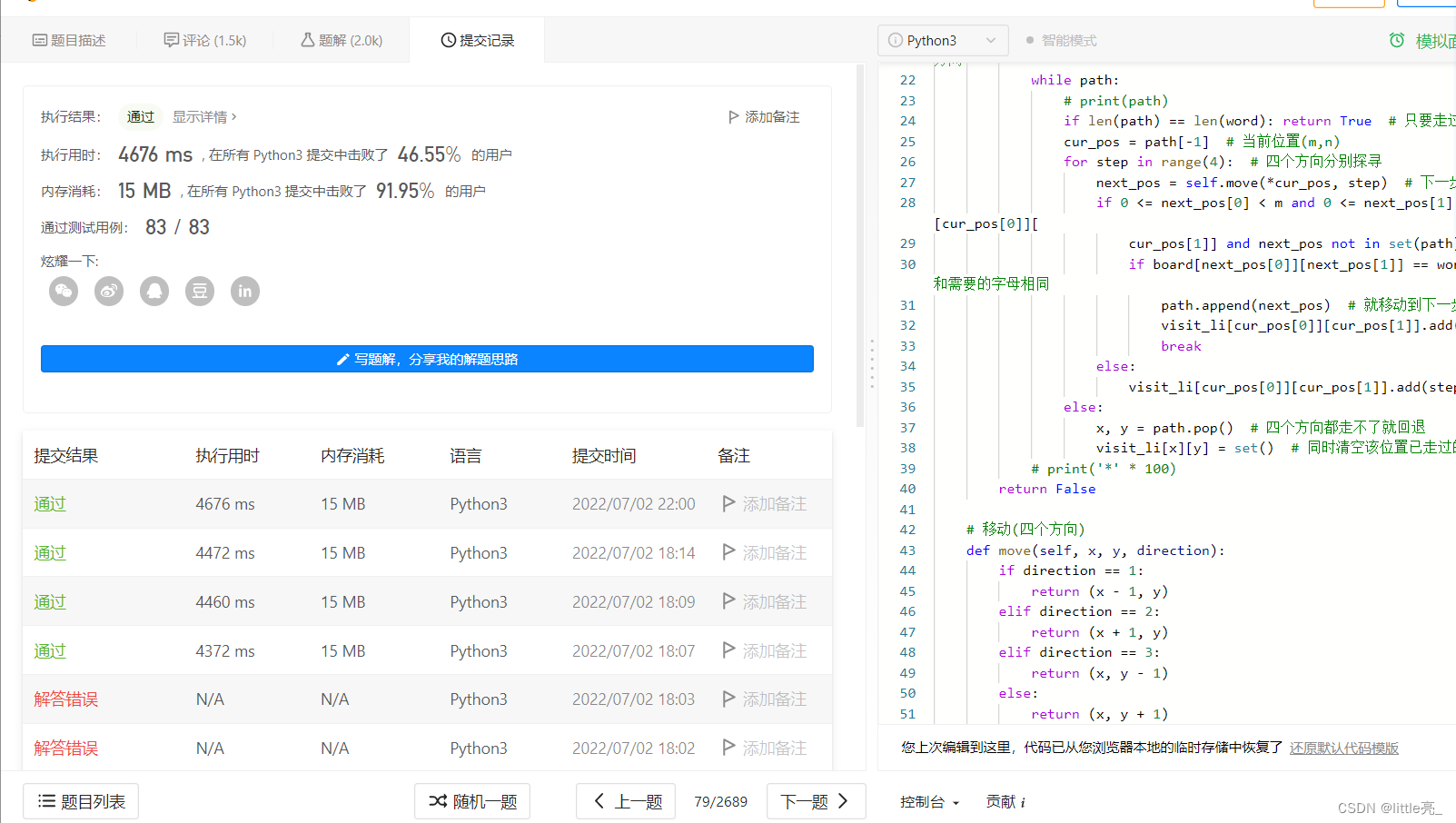
Synchronous update in personal blog system :LeetCode Word search ( To solve by backtracking )
边栏推荐
- MD5 bypass
- 2022 thinking of mathematical modeling C problem of American college students / analysis of 2022 American competition C problem
- 2021 electrician cup idea + code - photovoltaic building integration plate index development trend analysis and prediction: prediction planning issues
- 2022 American College Students' mathematical modeling ABCDEF problem thinking /2022 American match ABCDEF problem analysis
- Detailed introduction of OSPF header message
- Establish cloth effect in 10 seconds
- Rip notes [rip message security authentication, increase of rip interface measurement]
- 计组笔记(1)——校验码、原补码乘除计算、浮点数计算
- Reading and visualization of DICOM, MHD and raw files in medical imaging
- LeetCode之单词搜索(回溯法求解)
猜你喜欢
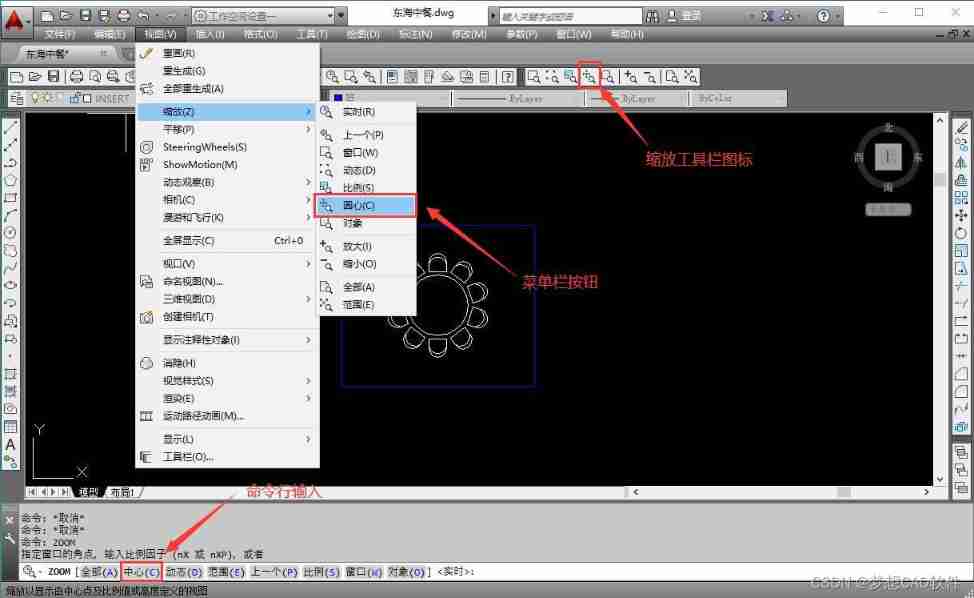
AutoCAD - Center zoom
![[Business Research Report] Research Report on male consumption trends in other economic times -- with download link](/img/08/7ea490c46c3f64af3e78d07b19b3e3.jpg)
[Business Research Report] Research Report on male consumption trends in other economic times -- with download link

2022 thinking of mathematical modeling D problem of American college students / analysis of 2022 American competition D problem
![[groovy] closure (Introduction to closure class closure | this, owner, delegate member assignment and source code analysis)](/img/aa/3c8b7b27e322417777d1315b9a5a8f.jpg)
[groovy] closure (Introduction to closure class closure | this, owner, delegate member assignment and source code analysis)

Emlog博客主题模板源码简约好看响应式
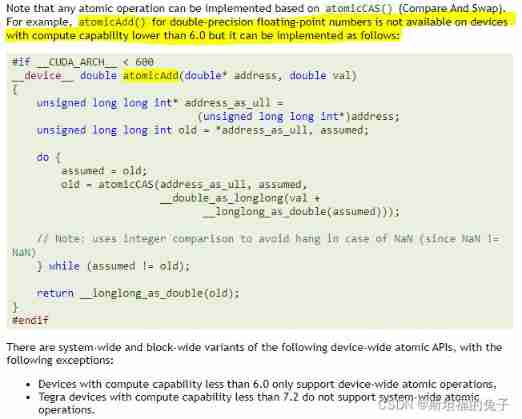
CUDA Programming atomic operation atomicadd reports error err:msb3721, return code 1
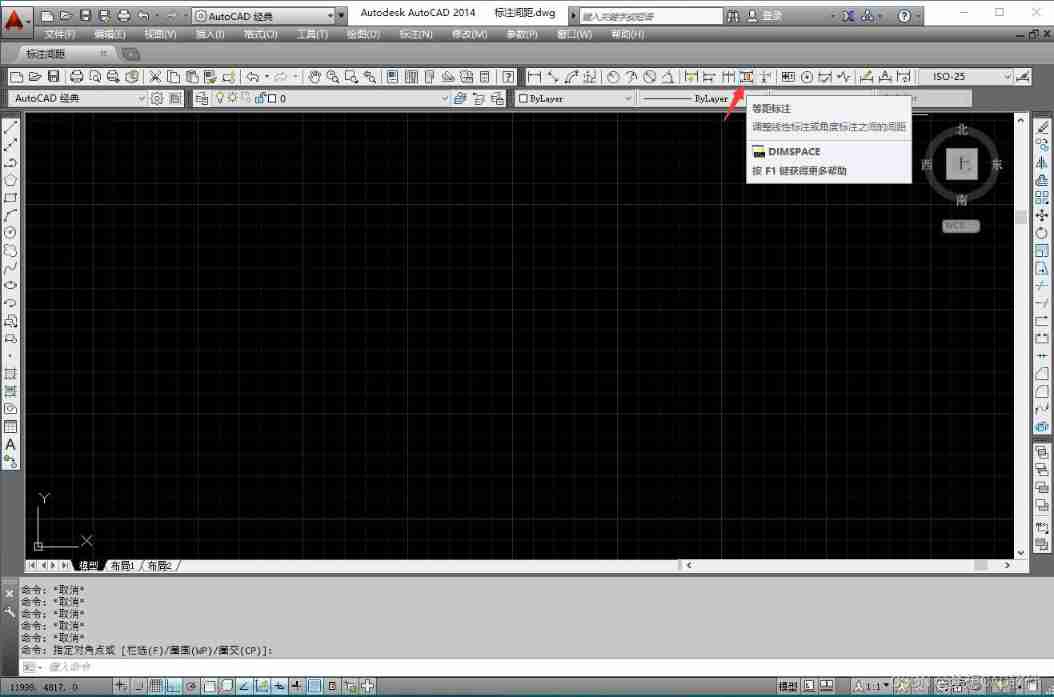
AutoCAD - isometric annotation
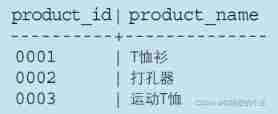
SQL set operation
![[Business Research Report] top ten trends of science and technology and it in 2022 - with download link](/img/9f/4fc63fa7b0e9afc5dd638d4b599b2c.jpg)
[Business Research Report] top ten trends of science and technology and it in 2022 - with download link

2021-10-29
随机推荐
CSDN body auto generate directory
[groovy] closure (Introduction to closure class closure | closure parametertypes and maximumnumberofparameters member usage)
MD5绕过
Unity synergy
How to choose a panoramic camera that suits you?
2021 Higher Education Club Cup mathematical modeling national tournament ABCD problem - problem solving ideas
Difference between singleton and factory pattern
[ideas] 2021 may day mathematical modeling competition / May Day mathematical modeling ideas + references + codes
MySQL audit log Archive
AutoCAD - stretching
China as resin Market Research and investment forecast report (2022 Edition)
2022 thinking of mathematical modeling a problem of American college students / analysis of 2022 American competition a problem
Rip notes [rip message security authentication, increase of rip interface measurement]
【acwing】240. food chain
[Chongqing Guangdong education] National Open University 2047t commercial bank operation and management reference test in autumn 2018
669. Prune binary search tree ●●
2021 electrician cup idea + code - photovoltaic building integration plate index development trend analysis and prediction: prediction planning issues
[groovy] closure (closure parameter list rule | default parameter list | do not receive parameters | receive custom parameters)
AutoCAD - isometric annotation
"Measuring curve length" of CAD dream drawing



